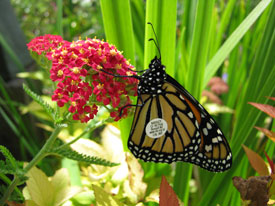Summer colour for butterflies
Now is the time to begin loading colourful plants into your garden to ensure you have a blazing display to attract as many butterflies as possible. Butterflies are attracted to a colourful scene and will even fight over an appealing area claiming territory
On a hot summer day male butterflies will patrol an area watching out for females to mate with and ready to attack any rival males that cruise past.
There will be aerial dogfights over good flowers. The butterflies don’t really care what kind of flowers you have, but will be looking for quantity.
The longer your flowering display, the longer you will see butterflies. Remember that butterflies have poor eyesight and will be looking for masses of colour. The variety of flowers found in ‘cottage garden’ plantings is stimulating and the different height and leaf structures afford protection from predators.
Most garden centres sell potted colour and have an area dedicated to displaying these colourful plants. Potted colour is flowering at the time of purchase and is great for instant impact. You won’t require lots of these, but the more the merrier. Reasonably priced you can usually buy a few for under $10, and they can be used as they are, or planted on into pots baskets and borders where there are gaps in the display. If you are starting a new garden, have limited space on an apartment deck or have acres of garden to fill, you’ll get lots of mileage from these plants.
Plant a few sunflower seeds as the ground warms up in spring to add a magical feel to any area. Look at the height listed on the seed packet and plant the seeds in an area where the surrounding plants will be slightly lower than your sunflower thereby ensuring that they stand above their neighbours. Plant alone or in groups of three. You’ll be thrilled by the theatrical presence of their big leaves, impressive flowers, and magnificent seed-heads providing you with plenty more for next year. If you have room try sunflower ‘Giant Russian’ or ‘Skyscraper’ for massive flowers that cannot fail to knock your socks off.
Plant a new perennial or two each year and let them colonise a spot. They only require an annual cut back in autumn and they will surprise you each year as the colony grows in both the area it will inhabit, and the ever increasing flourish of flowers. Mulch heavily to 5cm deep around all perennial clumps, and fill any gaps with a few potted colour until the main displays begin in late spring and summer.
Butterflies will be looking for host plants on which to lay their eggs. Plant a few more swan plants for your Monarch caterpillars and a nettle or two to attract our gorgeous NZ Admiral butterflies too. The Admirals will lay eggs on your nettles if they’re around. Admiral eggs look very different from Monarch eggs, being both smaller in size and easily missed due to their clear colour. You will find the Admiral eggs on the ends of the nettle spines themselves, sort of suspended in space, rather that against the leaf cuticle as with a Monarch egg.
For some great inspiration and ideas enrol in the ‘Create Butterfly Habitat’ on line course. It’s easy to study at home – all you need is your computer and an internet connection.
Happy gardening all!
For more information please visit www.nzbutterflies.org.nz.
Article reproduced with permission from the Moths and Butterflies of New Zealand Trust.
Story and photo by Jane Carver
23-Sep-2013

Achillea Red Baron and a tagged monarch

